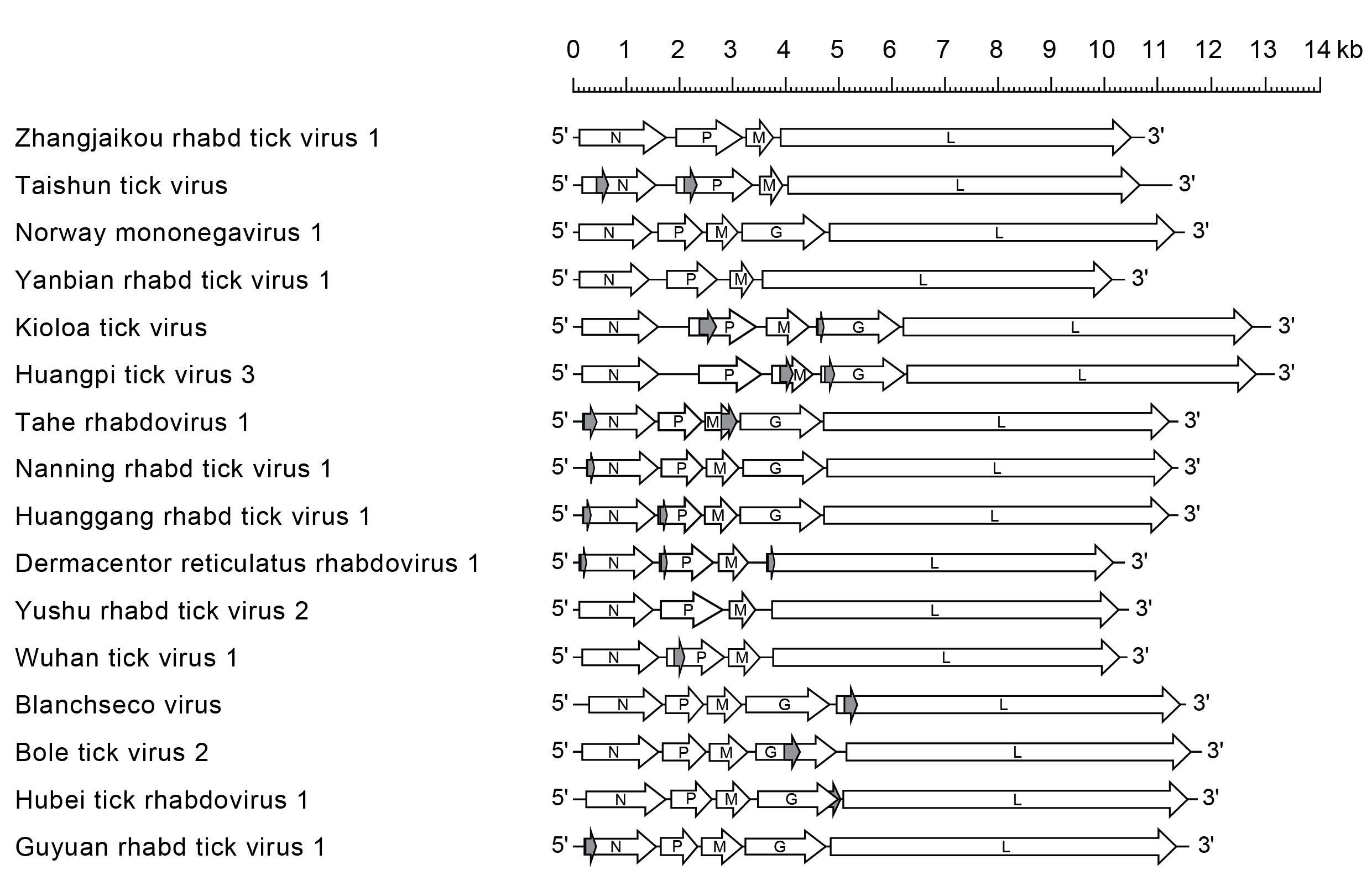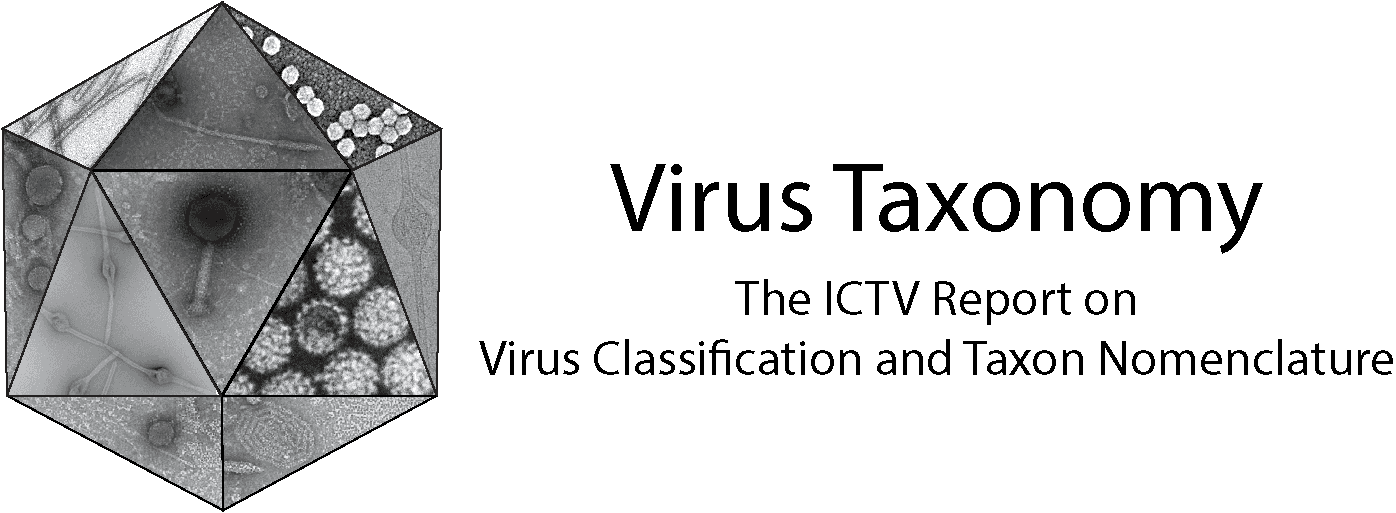Subfamily: Alpharhabdovirinae
Genus: Alpharicinrhavirus
Distinguishing features
Viruses assigned to the genus Alpharicinrhavirus form a distinct monophyletic group based on well-supported Maximum Likelihood or Maximum Clade Credibility trees inferred from complete L sequences. Members of the genus have been detected in hard ticks (family Ixodidae). They are distant phylogenetically from viruses assigned to the genera Betaricinrhavirus and Gammaricinrhavirus.
Virion
Morphology
Viruses assigned to the genus have not yet been isolated or visualized by electron microscopy.
Nucleic acid
Alpharicinrhavirus genomes consist of a single molecule of negative-sense, single-stranded RNA and range from approximately 10.5–11.9 kb (Li et al., 2015, Pettersson et al., 2017, Sameroff et al., 2019, Xu et al., 2021, Gofton et al., 2022).
Proteins
Alpharicinrhavirus N, P, M, G and L proteins share sequence homology and/or structural characteristics with the cognate proteins of other rhabdoviruses. Several alpharicinrhaviruses (Wuhan tick virus 1, species Alpharicinrhavirus wuhan; Huanggang rhabd tick virus 1, species Alpharicinrhavirus huanggang; Nanning rhabd tick virus 1, species Alpharicinrhavirus nanning; Taishun tick virus, species Alpharhicirhavirus taishun; Yanbian rhabd tick virus 1, species Alpharicinrhavirus jilin; and Zhangjaikou rhabd tick virus 1, species Alpharicinrhavirus zhangjaikou) lack a gene encoding the class I transmembrane glycoprotein (G). Alignment of the G proteins of other alpharicinrhaviruses with the G protein of vesicular stomatitis Indiana virus indicates they share all 12 conserved cysteine residues that are typical of animal rhabdovirus G proteins (Walker and Kongsuwan 1999, Roche et al., 2006).
Genome organisation and replication
Alpharicinrhavirus genomes include only the five genes (N, P, M, G and L) encoding the structural proteins (Figure 1 Alpharicinrhavirus). The absence of the G gene in two samples of Wuhan tick virus 1 (WhTV1) collected in different locations and at different times, as well as in five other alpharicinrhaviruses, indicates this is a genuine gene deletion rather than a sequencing artifact. Alternative small ORFs (>180 nt) occur in some genes. It is not known if they are expressed but small ORFs in P and L genes of the two available samples of WhTV1 are conserved.
 |
| Figure 1 Alpharicinrhavirus. Schematic representation of genomes of alpharicinrhaviruses shown in reverse (positive-sense) polarity. The five long open reading frames (ORFs) in the N, P, M, G and L genes are shown (open arrows). Alternative ORFs (>180 nt) in some genes are also shown (grey) but it is not known if they are expressed. |
Biology
All alpharicinrhaviruses have been detected by metagenomic sequencing of hard ticks (family Ixodidae) of various species and from multiple provinces of China, Thailand, Ausralia, Croatia, Norway or the Caribbean island of Trinidad (Li et al., 2015, Pettersson et al., 2017, Sameroff et al., 2019, Temmam et al., 2019, Shi et al., 2021, Xu et al., 2021, Gofton et al., 2022). No isolates are currently available for any of these viruses.
Species demarcation criteria
Viruses assigned to different species within the genus have several of the following characteristics: A) minimum amino acid sequence divergence of 10% in the N proteins; B) minimum amino acid sequence divergence of 10% in the L proteins; C) minimum amino acid sequence divergence of 15% in the G proteins; D) significant differences in genome organisation as evidenced by numbers and locations of ORFs; E) can be distinguished in virus neutralisation tests; and F) occupy different ecological niches as evidenced by differences in arthropod and/ or vertebrate hosts.
Related, unclassified viruses
| Virus name | Accession number | Virus abbreviation |
| American dog tick rhabdovirus 2 | MF962659; MF962661* | ADTRV2 |
| Guandong tick Manly virus | OM264164* | GdTMV
|
| Manly virus | MK026564* | MLYV |
| Nayan tick rhabdovirus | KP141757* | NyTRV |
| Norway mononegavirus 1-like virus | MH560586* | NMNLV1 |
| Qingyang rhabd tick virus 1 | ON746522* | QyRTV1 |
| Tacheng tick virus 3 | KM817640* | TcTV3 |
| Tahe rhabdovirus 2 | ON408171 | ThRV2 |
| Tongren rhabd tick virus 3 | ON746535* | TrRTV3 |
| Wufeng shrew rhabdovirus 12 | OQ715730* | WfSRV12 |
| Wufeng shrew rhabdovirus 13 | OQ715710* | WfSRV13 |
| Wufeng shrew rhabdovirus 14 | OQ715731* | WfSRV14 |
| Zhangjaikou rhabd tick virus 2 | ON746533* | ZjRTV2 |
| Zhangye rhabd tick virus 1 | ON746538* | ZyRTV1 |
Virus names and virus abbreviations are not official ICTV designations.
* Coding region sequence incomplete

